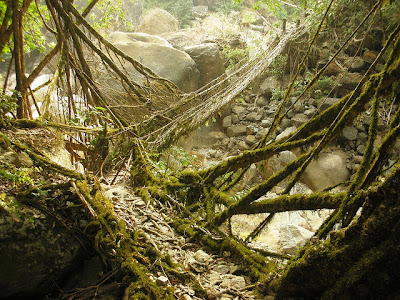Cherrapunjee being the wettest land on the earth, because of rains throughout the year has numerous waterfalls falling from great heights. Nohkalikai Falls is one of them, falling from the height of 1100 feet or 335 m. This is the tallest waterfall of India. As the collected rainwater on the summit of a small plateau give birth to this waterfall the intensity of the fall decreases during dry seasons that is in between December and February. The waterfall falls enthusiastically from this great height to the hard rocks to form a fantastic green colored pool, which is really an eye -catcher. This great fall lead to the formation of a big cavity behind the fall.
A variety of Indian rubber tree growing along the banks of the rivers or the streams of this hilly region scientifically named Ficus elastica, give out prop roots from the trunks of the trees. These prop roots are well known for their strength to carry heavy weights. These trees can grow easily on huge boulders besides the river or stream and can send their secondary roots to the riverbed for absorption of water and mineral, so the soil erosion caused by the fast flowing rivers and the streams do not affect them.
These bridges have great strength that they can carry even the load of 50 or more people at a time and as the roots of these bridges are living their strength grow with the passing years.
Tourists can even hop around on the Double Decker Root Bridge , which is made of two bridges piled one above the other. This particular bridge in located in Nongriat village of cherrapunji and named as Umshiang Double Decker Bridge , as it is built over the stream named Umshiang . This bridge is considered to be very special one as it is the unique one in the entire world.
Around 10 to 15 years are required by these bridges to become operational and they have a life span of around 500 to 600 years. This is an excellent example of bioengineering.
Explore cherrapunji @ www.hoparoundindia.com
Explore cherrapunji @ www.hoparoundindia.com









Good stuff. I really love to these kind travel places like river, waterfall, dams etc.Romania Tours
ReplyDeleteNice post... I love this kind of travel stuff to guide travel buddies...
ReplyDelete